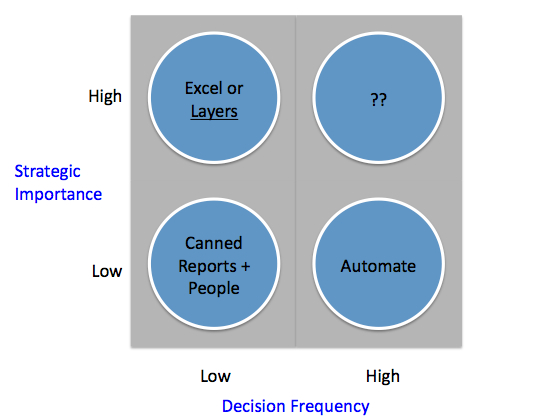Does Your Business Have a Decision Making Model?
post by Chris Curran on October 15, 2010Larry Dignan (@ldignan), ZDNets Editor in Chief, recently referenced a post written by my friend Vinnie Mirchandani at Deal Architect. In it, Vinnie makes several interesting assertions about the effectiveness of analytics in the enterprise. For example, he thinks that many companies can’t or don’t want to deal with the truth in the data because they won’t like the answers.
I’ve been thinking a lot about analytics and its role in business decision making while preparing for Computerworld’s BI conference a few weeks ago (get the presentation @ SlideShare). As I put my thoughts together, I was happy to see this statement from Vinnie - one I really liked:
Most analysts focus on slice and dice, not decisions. Most vendors sell slice and dice.
This summarizes the core of the information analysis problem for IT. We spend way too much time organizing, storing, reporting, tooling and visualizing the data we have (inside-out) versus looking at the business decisions we are trying to make and working back from there (outside-in). A decision making model may help you better connect your information initiatives with business priorities and value.
Decision Making Models
There is a ton of hard science and some pop science around the way people make decisions and the way we can better understand it, both from our own personal perspective as consumers and as executives dealing with various stakeholders. For some interesting reading on how individuals make decisions, check out either of Diamond Fellow Dan Ariely’s books, Predictably Irrational or The Upside of Irrationality. The best book I’ve found explaining managerial decision making models is Winning Decisions by Russo and Schoemaker where the first step is deciding what is a decision and if you will even choose to make the decision (cue Rush’s Freewill). I also recommend a series of decision-making posts on Russ Aebig’s Directionally Correct blog. I’ll leave the science of decision making to the experts. What I would like to explore is the management of decision making and its support.
In that vein, there are two kinds of models fundamental to driving our information strategies using decisions rather than data:
- What decisions are important?
- How will we support the decision-making with information and tools?
Several years ago, I worked with a mobile telecommunications expert with particular depth in analyzing all of the information that goes into launching and building successful mobile carriers. A typical projects for him involved an analysis of customer usage data to optimize pricing, plans and ultimately, customer retention. He typically responded to a marketing or product executive with a burning platform around a particular customer retention issue. His approach was to develop a very customized set of spreadsheets and databases tailored to the specific product or pricing decision at hand. These were the kinds of decision his clients would make 1-2 times a year.
As a technology guy, I went straight to the “why don’t you guys build a system to do that?” question. Reflecting on those discussions now, I think he recognized the value of understanding the type and frequency of the decision and matched it to the right approaches and tools.
For a very important strategic decision that you may only make 1-2 times a year, maybe you can relax your use of standard BI tools and try using a toolset more simple, fast and flexible? Layers is a term that my colleague John Sviokla and I coined to describe a this approach, which we will cover in a future post. The following framework is a simple way you could look at your information related projects to look for candidates to simplify and streamline.
Developing a model to communicate that every type of decision doesn’t require a new data warehouse or BI system may help you rationalize your information initiatives and BI architectures and tools. What do you think?
cc licensed flickr photo shared by Freddy The Boy





Pingback: When Enterprise Apps Become Mindful — CIO Dashboard()